In the
wild, all
hosta species have the ability to reproduce by
seed but some are more prolific than others. Hostas are
in the group of plants that have
perfect flowers. That means that they have both male
(stamen) and female (pistil) reproductive organs in the
same flower. Therefore, seeds can develop through
fertilization with pollen from the same plant i.e.
self-pollination a.k.a. selfing, or pollen from another
plant i.e. cross-pollination.
Either
way, the resulting seed will be the mixture of two
different sets of genetic material. This variability
means that the offspring i.e. seedlings, may have some
unusual or new traits not exhibited by either parent.
That fact opens the way for discovering a new cultivar
among a group of seedlings. Gardeners, hybridizers and
nursery people use this characteristic of plants in two
ways:
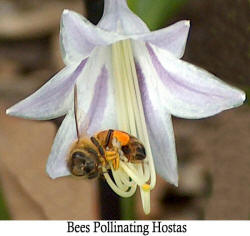
_ A. Let Nature Do the Job
- A certain number of new hosta cultivars are simply
"found" in the garden or nursery. Hostas are generally
pollinated with the help of bees. The insects get up
early in the morning, buzz around the newly opened hosta
flowers and carry pollen from one to another. So, in the
case of these random acts of nature, you might know the
name of the mother plant from which the seeds were
gathered but you won't know the name of the father or
pollen parent. If the seedlings just sprouted up where
the seeds dropped the previous fall, you won’t know the
name of either parent for sure.
Extremely knowledgeable
hostaphiles like
Mark Zilis,
Bob Solberg or
W. George Schmid might be able to make an educated
guess as to the parentage based on physical traits but
it would only be an opinion. I suppose with today's
technology, we could do a DNA analysis and might be able
to figure it out but that would be very expensive. Maybe
in the "Star Trek" future, we could just wave our cell
phone at the plant and a free app we download from the
internet would determine the plant's genetic background.
Who knows? Anyway, these types of cultivars are called
open-pollinated and are often registered as "parentage
unknown".
_ B. Get People Involved
- Of course we humans have a burning desire to get
involved and control nature if we can. So, since the
time we learned the mechanics of how plants reproduce,
we have been manipulating the plant world through a
process called hybridization.
Hybridizing generally involves the combination of the
genetic materials from two different plants. For this
cross-pollination to work, of course, both plants need
to be in flower at the same time. Often, hybridizers
take the pollen from a plant and place it on the pistil
of the same plant which is called self-pollination or
simply, selfing.
The
whole idea of a person going out into the garden to
collect pollen from one plant and putting it on the
pistil of another is to try to combine the good traits
of each while de-emphasizing the bad traits.
_
1. History of Hosta Hybridizing - It appears
that gardeners and horticulturists in the hosta native
lands of
Japan, Korea and China may have been selecting
open-pollinated plants or manually hybridizing hostas
for a long time before Europeans came on the scene.
However, one of the early documented cases of
hybridization of hostas in the West was done by
Georg Arends in Germany. He is best known for
hybridizing astilbes (Astilbe
x arendsii), but Arends also introduced
perhaps the all-time classic blue cultivar, Hosta
sieboldiana 'Elegans'
in 1905. It is thought to be the result of a cross
between
Hosta sieboldiana x H. 'Tokudama'.
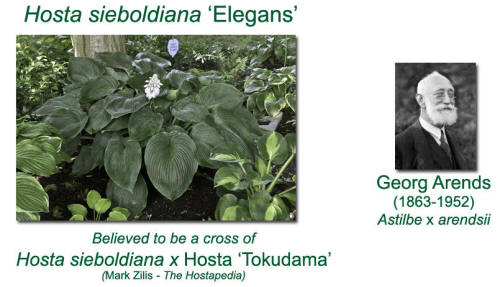
Mr.
PGC Comment: By the way, the proper way to show the
plants involved in a cross-pollination is to list the
mother plant i.e. pod parent first, followed by a cross,
x, and then the father plant i.e. pollen parent, second.
For example, H. sieboldiana x H. 'Tokudama'.
When talking about this cross it would be spoken as,
"Pod parent, H. sieboldiana, by pollen parent, H.
'Tokudama'."
Another
early hybridizer of renown was Eric Smith who lived in
Dorset,
England. A nurseryman who was then working at
the famous
Sir Harold Hilliers Nursery called Buckshaw Gardens,
Smith was looking to develop smaller hostas with great
blue color. In the summer of 1961, he took advantage of
a fluke occurrence when a plant of Hosta sieboldiana
'Alba' bloomed unusually late one summer so he could use
its pollen to fertilize the flowers of an H. 'Tardiflora'
plant.
The
whole story of Smith's hostas gets a little complex but
suffice it to say, that his original cross spawned a
whole
series of smaller, blue-green plants commonly called
the "Tardianas". The seedlings of the first cross where
designated as the F1 generation and the second
generation plants were the F2s. This was part of Smith's
numbering system where he simply named a plant TF1 x 1,
TF1 x 2, etc.
Smith
himself did not register any of his 34
Tardiana hostas. Fortunately, other people including
Paul Aden,
Alex J. Summers and the British Hosta and
Hemerocallis Society named and registered the plants on
Smith's behalf starting in the mid-1970s. Of course,
many of the plants have the word "blue" in the name such
as H. 'Blue Moon', H. 'Blue Skies', etc. Others have the
term "Dorset" in the name including H. 'Dorset Charm',
H. 'Dorset Flair', H. 'Dorset Blue' etc. Finally, the
term "Hadspen" such as H. 'Hadspen Heron', H. 'Hadspen
Hawk' and H. 'Hadspen Pink' appears in this line of
hostas.
Mr.
PGC Link: For more information on the
Originators and Hybridizers of hosta cultivars, see
the
HostaHelper.
_
2. Goals of Hybridizing - Hybridizing hostas may
be as simple as wandering around your garden, collecting
some seeds and growing them to see what you get.
However, for most people who call themselves
"hybridizers" it is a much more thoughtful process. They
set goals that they want to achieve in their programs
and work consciously toward making those goals a
reality.
Generally, the hybridizer will choose one or more
specific traits that they would like to "improve" and
pick pod and pollen parent plants accordingly. They may
try to create a "bluer" blue hosta or one that has
fragrant flowers or better leaf substance on a highly
variegated, thin substanced cultivar. While creating
changes, they may desire to keep certain characteristics
such as leaf shape, flower color, bloom season or plant
form unchanged. As mentioned before, you want to
accentuate the desirable traits while minimizing or
eliminating those that are not desirable.
All of
this sounds so simple and straightforward but in the
world of genetics, it can be quite a challenge. Just ask
any hybridizer how many times they are successful in
their quest and most will say they are lucky if one
plant in hundreds of seedlings shows real promise.
_
3. Approaches to Hybridizing
_
a. Open Pollination - As discussed
earlier, you can simply let nature do its thing and see
what happens. Randomly collected seeds will be
considered open-pollinated since you have no idea where
the pollen originated. It is believed that in many
cases, the pollen comes from the same plant as the bees
brush up against the stamen and then crawl over to the
pistils. That would make seeds from these plants not
"technically" hybrids since all the genetic material
came from the same plant. However, the resulting
seedlings may still have some variable traits.
The
only hostas that come perfectly true to type from seed
are plants of the species, Hosta ventricosa. In a
process called apomixis, seeds are formed in an
asexual way (does not require the mixing of pollen onto
the pistil) that results in exact genetic copies of the
mother plant. Strange but true.
_
b. Line Breeding - This is a process
where plants that are closely related are bred to each
other. For example, you might take the pollen from the
seedling of a mother plant and use it to pollinate the
same mother plant. The intention of "inbreeding" is to
isolate certain traits that are recessive and may
express themselves during this process. By continuing
the line breeding route over several generations, the
hybridizer is hoping to either accentuate or eliminate a
specific trait or traits.
_
c. Cross Breeding or Outbreeding -
Cross-breeding occurs when you take the pollen from a
father plant and transfer it to the pistil of an
unrelated mother plant. The idea here is to take a plant
with a desirable trait and add that trait to the mother
plant. Or, it could be to eliminate an undesirable trait
from the mother plant. Perhaps the mother plant has
roundish leaves and you cross it with a plant that has
narrow leaves in an effort to reduce the leaf width.
_
d. Self-Pollinating or Selfing - As
the name implies, this process takes the pollen from a
plant and applies it to the same plant's pistil. The
desired outcome is often that the seedlings may show
enhanced characteristics of the mother plant through
expression of genetically recessive traits.
_
e. Combinations - Of course in their
never ending quest for better hostas, hybridizers will
sometimes have to resort to using combinations of these
techniques. They may start out by line breeding a
particular plant and then finish by crossing it with a
separate cultivar or species plants to see what results.
It can be an involved and fun game.
_
4. The Hybridization Process - As described
earlier, in order to produce seeds, pollen from the male
organ (stamen) must somehow reach the top of the female
organ (pistil) and then travel down into the ovary to
fertilize the eggs. In the hosta garden, this is
generally done by bees, but humans can easily do the job
too.
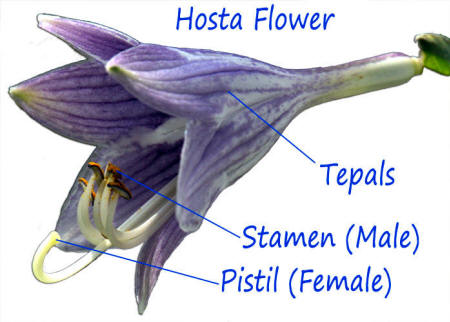
We can
describe the basic procedures here and that will give
you an idea of what is involved in hosta hybridizing.
However, as with any biological process, there are
always exceptions and subtle "quirks" that cause
problems or create opportunities for the hybridizer.
Learning to effectively deal with these unique
situations is what keeps hybridizers working on the
process for years while they discover new things about
hostas. There are even several organizations of people
devoted to hosta hybridizing where members share their
techniques and solutions to problems they encounter.
So,
here is the basic process that you can use to give
hybridizing a try.
_
a. Identify two hostas that are in bloom
at the same time in your garden. You could do this
randomly or, as we discussed, you can isolate a specific
trait or traits in each plant that you want to impact in
some way through your cross.
_
b. Like
daylilies, hosta flowers only
bloom for one day. They begin to open around 3 a.m. and
should be fully open well before sunrise. This means the
pollination process needs to be completed in one outing
for any particular flower since it will shrivel and fade
away if it is not pollinated that day.
_
c. The next step is to make sure that
bees do not pollinate the flowers before you do. There
are several ways of accomplishing this task. The tepals
(petals plus sepals) of the flower are what attract the
bees, so one approach is to go into the garden around
sunrise and gently strip them from the flowers of the
mother plants. Also carefully remove the stamens
(unless you are doing a self-pollination) leaving only
the pistil exposed.
If the
flower has been prepped properly, the pistil will be
slightly curved upward and the top end i.e. the stigma,
will be enlarged. Pistils that are straight up and down
with no curve are not ready to be pollinated and you
might need to go through the process again the next day
on that plant...and, of course, on a new flower.
Another
approach is to somehow cover the flower so that bees
cannot get to it. On plants in the shade, you can simply
put the flower into a plastic bread bag secured with a
tie down. In sunny situations where the flower may "fry"
under plastic on a sunny morning, you can use some very
fine mesh netting to cover the flower. Mosquito netting
type material should work fine.
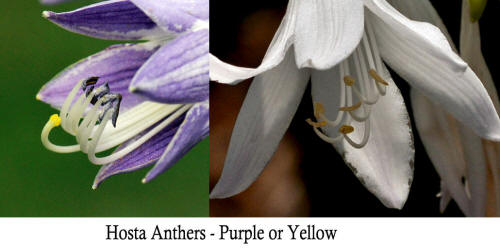
_
d. Many hybridizers recommend collecting
the pollen from the father plant well in advance of
making the cross. If you wait too long, the bees may be
active and might have disbursed all the pollen before
you get to it. Complicating the process is that the
pollen needs to warm a bit in order to "ripen" properly
and this may not happen until well after sunup in the
garden.
You can
go out the night before making your crosses and remove
the stamens from unopened flowers of your selected
father plants. Be sure to have a system for keeping
track of the name of the plant where each stamen
originated for your records.
When
collected in this way, the stamens will have no yellow
color. Store them overnight in a warm, dry place and, by
the morning, they should be covered with a fluffy yellow
powder...the pollen. If this has not happened, you can
try gently warming the anthers to promote the pollen
formation. Be sure to keep stamens from different plants
physically separated from each other to prevent
contamination.
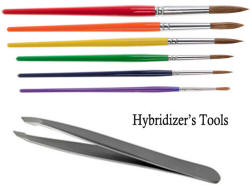
_
e. Later in the morning when the air
temperature has increased, it is time to actually apply
the pollen to the pistil of the mother plant. There are
several methods for transferring the pollen but the key
is that you must be very careful not to mix pollen from
two plants. This would mess up the whole process.
One
approach is to take several clean, small paint brushes
with you into the garden. That way, you can use a
different one for each of your crosses to avoid
contamination. Brush the stamen of the pollen parent and
then apply the pollen to the top of the mother plant’s
pistil. When you are done, be sure to thoroughly clean
all the brushes before your next round of hybridizing.
Another
common approach is to actually remove the stamen from
the pollen parent and, using a pair of tweezers, move it
over to the mother plant. Gently rub the top of the
stamen onto the top of the pistil to make the transfer.
Be sure to thoroughly wipe off the tweezers between
crosses to avoid contamination.
If you
really get into hybridization, you will hear about many
other techniques for transferring the pollen. Some of
them are very inventive...and some are just a little
strange but it does not matter as long as the method
works and viable seed is produced.
_
f. One of the key elements to successful
hybridizing of hostas is to keep accurate records of the
parent plants used in each cross. To do this, you MUST
keep detailed records all the way from the day the cross
is made through growing the seedling onward for 5 or 6
years. Lost or inaccurate labels are the bane of
hybridizers' lives.
Immediately after you make the cross, you need to have a
method for labeling the mother plant and the seed pod
that will (hopefully) develop. Many hybridizers use
jeweler's tags which can be filled out in the house the
night before and then tied onto the flower stem when the
cross has been made. Use a fine tip, UV resistant pen to
assure that the label will be readable at the time of
harvest a month or more later.
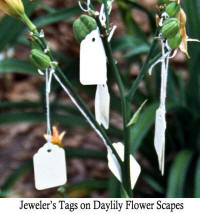
Since
the space on the label is limited, you will have to
develop your own coding system. The key here is to write
everything down and to make multiple copies of it on
paper and in your computer. It is awful to come to some
point in the long hybridizing process, look at a label
that says, "LY3-t788-012" and have no idea what that all
means.
Another
approach to identifying seed pods is to use small pieces
of electrical wire. These are available in many
different colors and you can come up with a system using
different combinations. For example, twisting two pieces
of yellow, one of red, two of green and a single blue
wire on a seed pod may stand for H. 'Sum
and Substance' x H. 'Blue Moon' made in the fall of
2012. Again, keep good records and keep multiple copies.

_
g. If you were successful in your efforts
in hand pollinating, a seed pod should begin to develop
within about 4 or 5 days. This will begin with a
swelling at the base of the pistil where the ovaries are
located. If the cross did not "take", the ovary will
turn yellow and drop off the plant. A pod with viable
seeds in it will be firmly attached to the stem and will
not fall off by being shaken by the wind or when you
pollinate another flower on the same stalk later in the
bloom period.
Mr.
PGC Comment: Don't automatically assume you did
something "wrong" if the cross does not work. Hostas are
notorious for being unpredictable when it comes to
setting seeds. It could have been high temperatures, low
humidity, dryness and other factors out of your control
that caused the failure. Or...it could have been your
poor technique...sorry.
_
h. It takes about 30 days after
pollination for hosta seeds to develop to maturity or
"ripeness". That is why certain hosta species such as
those which flower very late in the season are quite
difficult to hybridize in northern gardens where frost
hits before seeds have had time to mature. For most
hostas in the northern climates, this means that any
crosses made after Labor Day will probably not bear ripe
seeds unless warm weather persists.
_
i. Harvest the seeds when they are
mature. Although most people wait until the seed pods
have turned brown, the seeds within may actually be ripe
prior to that time. Mature seeds will be dark brown to
black in color with a single "wing" on them. These may
be harvested and either planted immediately or may be
kept for later planting. Put the seeds in a properly
labeled paper envelope and place them in the freezer if
you plan to keep them for an extended time before
planting.

_
j. Since hosta seeds do not have to go
through a "chilling" process like many other perennials,
hybridizers often plant their seeds indoors under
fluorescent light systems immediately after they are
harvested. Many keep the lights on for 24 hours a day to
push the growth of the seedlings at an accelerated rate.
_
k. Once the plants are growing on their
own, the time begins for perhaps the most difficult part
of the whole hybridizing process. After the seedlings
develop their third set of leaves, most hybridizers
begin the "culling process". This means that they start
pulling out and discarding any and all seedlings that do
not appear to meet their hybridizing goals. It sounds
cruel and, seems wasteful, but often over 99% of the
seedlings you produce will end up in the compost bin as
you search for that one special plant.
You
will probably want to set up some type of schedule for
your culling process. Some people cull in the spring and
then again in the fall while others pull out plants
whenever they happen to wander through the seedling
patch. Remember that you can always eliminate a plant
later but, once you have tossed it into the compost bin,
it is for all intense and purposes gone forever. So,
when it doubt, leave it alone.
Mr.
PGC Comment: Over the years, I have heard at least
one story of a visitor plucking a rejected seedling from
a hybridizer's compost pile and discovering what turned
out to be a very nice, new hosta cultivar.
_
l. Keep up the culling process for
several growing seasons until you have (with luck) a
plant or two that meet your goal(s). Watch that unique
hosta grow until 5 or 6 years after the seed was sown to
be sure that it is a plant worthy of introduction as a
new, named cultivar. Or, use it to continue your
hybridizing process.
That,
in a nutshell, is hosta hybridizing. As we mentioned
before, it can be just this or so much more depending on
how far you want to get into it. Hybridizing is a
wonderful way to keep learning and growing in your
knowledge of this great landscape perennial.
_ 5.
Variegated Seedlings - Hosta 'Unforgettable' is a
variegated plant with a blue-green center and
yellow-gold margin. Hosta 'Night before Christmas' is
variegated with a white center and green margin. If you
took the pollen from one (the father plant) and put it
on the pistil of the other (the mother plant), what
color seedlings would result? Would they have green or
white centers? Would their margins be green or gold or
some mixture of all of these colors?
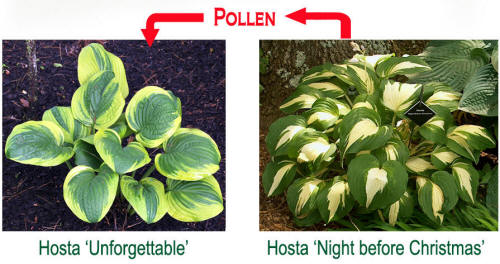
The
answer is that the seedlings would all be plain old
green or blue-green. Surprised? Well, the reason is that
(with one exception that we will discuss shortly), the
variegation on hostas is not a genetic trait. As
explained in the section on variegation, it is just a
change in the physical makeup of the pigment cells in
one or more of three of the many layers of leaf tissue.
Mr.
PGC Comment: I have a small birthmark on my arm that
is slightly reddish in color. This is just a change in
the pigment in my skin in that spot and is not part of
my genetic makeup. Therefore, it will not be transmitted
to my children. It is generally the same situation with
the variegation in hostas. There is a tiny, tiny
possibility that a genetic mutation might take place
resulting in the rare variegated seedling under these
hybridizing circumstances. Somewhere I heard the odds of
that happening are less than 1 in 10,000. Also, yes, the
"before" in H. 'Night before Christmas' is not
capitalized for some reason.

So, how
do hybridizers ever produce variegated seedlings? Well,
as mentioned above, there is one exception to the rule.
That occurs when the mother plant has splashed or
streaked variegation in its foliage.
If you
ever go to an auction at
The American Hosta Society convention, you will see
plants with streaked variegation being sold for some
very high prices. The reason is that hybridizers need
such plants to act as mother plants in their search for
variegated seedlings. They will spend hundreds and
hundreds of dollars to acquire streaked plants that have
other characteristics such as size, base color, leaf
shape, flower color, red petioles, etc. that they want
to work into their breeding programs.
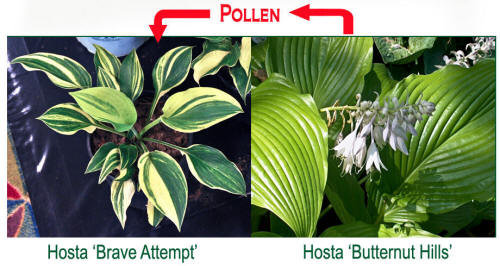
So, if
the hybridizer takes pollen from an all green father
plant such as H. 'Butternut Hills' and places it on the
pistil of a streaked mother plant such as H. 'Brave
Attempt', he or she will generally get a mixture of
solid, variegated (marginal or medial) and streaked
seedlings. Each seedling will have some of the genetic
characteristics of each parent and there might be one
that deserves to be introduced as a new, variegated
cultivar...or perhaps not.
The
unpredictable (and perhaps expensive) part of all of
this is that the variegation on most streaked plants is
notoriously unstable. There is a chance that next spring
when that streaked plant you paid so much for emerges
from the ground, it may have reverted to a single color
or to a non-streaked form of variegation i.e. marginal
or medial. If that happens, it will no longer produce
variegated seedlings and is just another hosta.
Mr.
PGC Comment: Remember that not all streaked
cultivars are so unstable. Some like H. 'Spilt Milk'
remain the same for decades and may only occasionally
have a single division or two that reverts.
_ 6.
Hybridizer Groups - Although some people take
hybridizing very seriously and may guard their special
techniques and knowledge jealously, most hosta
hybridizers are more than willing to share with others.
In many parts of the country, they have formed groups
dedicated to helping advance the science and practice of
hosta hybridizing for both the beginner and the expert.
If you are interested in participating in such a group,
the best way is to join The American Hosta Society and
your local and state hosta organizations. If there is a
hybridizer club functioning in your area, these groups
will surely know who to contact in order to join in the
fun.



